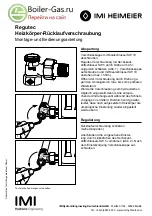
4
Ti100-200:
-3” male PVC
Exhaust Fitting.
3” Coupling
Field Provided
2.1 Location
In all cases, the Trinity boiler must be installed indoors, in a dry location, such that the gas components are protected from dripping or
spraying water or rain, during operation and servicing.
The boiler location ambient temperature is maintained to a minimum of 50
°
F.
Determine the best location of the vent termination, and if possible locate the boiler as close to the termination point as possible.
3.0 VENTING
The NY Thermal Trinity condensing gas boiler is a high efficiency boiler utilizing induced power venting. Exhaust gases are to be vented
directly outdoors, using the venting methods detailed in this section. Under no conditions may this unit vent gases into a masonry
chimney, unless it is vacant, and utilizes the Trinity approved venting material as illustrated in this section. Installation must comply with
local requirements and with the National Fuel Gas Code, ANSI Z223.1 for U.S. installations or CSA B149.1 for Canadian Installations.
Attaching Vent Piping to Boiler
•
It is extremely important for the intake and exhaust piping to be
adapted to the appropriate size immediately upon exiting the boiler cabinet. Ti100-200’s come with a 3”x1-1/2” PVC adapter to
be used to immediately connect to the air intake port of the boiler.
•
Ti100-200
exhaust connection is 3” male PVC, use approved cement to connect to venting system.
•
Ti400
exhaust connection accepts approved 4” venting material,
do not
insert PVC pipe directly into the exhaust connection;
PVC pipe could become deformed by the clamping force of the gear clamp. Only approved CPVC can be inserted into the Ti400
exhaust connection. Note: a 4” long piece of 4” CPVC is provided with the Ti400.
•
Check the flue outlet gasket for proper insertion and sealing prior to and after attaching the venting.
•
Ensure the venting system does not apply a load or stain on the flue outlet of the boiler (recommend using two elbows to create a
“swing joint” as shown above).
3.1 Vent Pipe Material
Exhaust Vent Piping:
•
The first
3 feet
of the exhaust venting must be readily accessible for inspection.
•
In
Canada
all exhaust pipe, fittings and cement must comply with
ULC S636
(ULC S636 PVC pipe is approved for flue gas
temperatures up to 149ºF (65ºC), therefore it can only be used in low temperature applications; systems requiring boiler supply
water temperature greater than 140ºF must use ULC S636 approved
CPVC
).
•
In
U.S.
exhaust pipe and fittings must comply with
ANSI/ASTM D1785
and
DF441
for PVC and CPVC, respectively. Cement
and primer must comply with
ANSI/ASTM D2564
and
F493
for PVC and CPVC respectively.
•
Ti100-200
•
3” PVC
Sch.40
(See note above for installations in Canada)
.
•
3” CPVC
Sch.40.
•
Ti400
•
4 or 6” PVC
Sch.40
(See note above for installations in Canada)
.
•
4 or 6” CPVC
Sch.40.
Air Supply Pipe:
•
3” ABS. (Use 4” or 6” for Ti400)
•
3” PVC
Sch.40. (Use 4” or 6” for Ti400)
Clearances
For proper and safe installation adhere to the following clearances to combustibles:
Boiler Casing=0" Floor=Combustible Flue Pipe: Boxed in or enclosed=2” In free air=0”
The following are the minimum clearances for servicing, however 24” is recommended:
Front = 24” Back = 0" Top = 12" Sides = 12" Bottom =
9" (0” for Ti400)
It is recomme nded that two
elbows be used, so that the slope
of the horizontal exhaust vent
does not affect the vertical plumb
of the pipe connected to the boiler.
Slope all horizontal indoor
exhaust venting ¼” to ½” per
linear foot.
Summary of Contents for Trinity Ti 100
Page 35: ...35 12 0 WIRING SCHEMATIC...





































